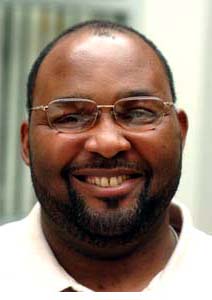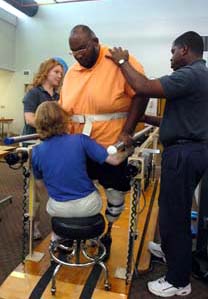JACKSON, Miss.—Tommie Wells awoke one night to find his right side felt numb, a strange sensation that he blamed on his diabetes medication.
The former Greenville police officer never imagined it was a stroke—he was only 34.
Given that most strokes do strike the elderly, Wells’ surprise was understandable. But he has since learned that it’s not just retirees who wind up in stroke rehab.
“Young people having strokes is a lot more significant in Mississippi than people realize,” said Peter Fayard, therapy manager for Methodist Rehabilitation Center’s stroke-specific rehab program. “We’ve had 133 patients under age 60 in the past three years.”
From January, 2002 through December, 2004, Fayard said Methodist’s comprehensive in-patient stroke program treated 66 new patients in their 50s, 53 in their 40s, 11 in their 30s, and 4 in their 20s.
Researchers have linked stroke in younger populations to a variety of causes, including heart abnormalities, sickle cell disease, Moya Moya disease, blood clotting disorders, hemophilia, circulation problems, recreational drug use, auto-immune disease and premature thickening of the arteries.
But Fayard says many young people fall victim to stroke the old-fashioned way. “It’s generally people who have traditional risk factors, such as diabetes, high blood pressure, high cholesterol, obesity and smoking. People sometimes assume that these risk factors won’t catch up with them until later. But for some people, later comes sooner than expected.”
It’s no coincidence that Wells’ stroke came on the heels of losing his lower legs to circulatory problems related to diabetes and high blood pressure. “Once you start seeing problems in the legs, there’s a good chance you’ll see them in the blood vessels of the heart, brain and neck, too,” explained Dr. James Williams, a physical rehabilitation physician at Methodist. “That’s why it’s important for people who have peripheral vascular disease to have the vessels in their heart and brain looked at, too.”
Damage to blood vessels elevates stroke risk because it can compromise blood flow and promote clotting. A stroke can occur if a clot blocks blood flow to the brain.
Each year, Methodist staff members share tips on how to prevent the nation’s third leading killer at stroke screenings across the community. The screenings also include a rundown of stroke symptoms because early medical treatment is critical.
“According to the National Institutes of Health, people who are treated within 90 minutes of the onset of symptoms show the most improvement,” said Dr. David Collipp, a physical rehabilitation physician at Methodist. “That means people can’t afford to take a wait-and-see approach.”
Like many Southerners who suffer strokes, Wells came into this world with the odds stacked against him. His risk factors include his race (African-Americans have a higher rate of stroke) and his family history (several relatives have diabetes and/or high blood pressure).
While such factors can’t be controlled, Dr. Williams said a healthy lifestyle can help reduce risk factors such as obesity, high cholesterol and high blood pressure. “You can exercise, modify your diet, stop smoking and take medications to treat high blood pressure and high cholesterol,” he said. “If you have diabetes, lowering your blood pressure is believed to be especially important.”
Wells is working on a healthier lifestyle. He works out several days a week at Methodist’s outpatient rehabilitation clinic in Flowood. And he has turned his back on his old eating habits. “Shipley Donuts were my friends,” he confessed. “Now I’m exercising, eating the right food and keeping myself active. The therapists at Methodist have worked tremendously hard with me.”
Fayard said Wells benefited from having access to Methodist’s stroke-specific rehab program – the only one in the state. “Having worked with adult stroke patients for 15 years, I feel very strongly that stroke is not just general rehab. It’s very challenging because of the complexity of the impairments that a stroke can leave. It’s across all systems – sensory motor, cognitive and communicative.”
Wells also was fortunate to receive in-patient therapy at Methodist immediately following his discharge from acute care, Fayard said. “Occasionally we run across people who are discharged straight home and that’s like going back to the 1950s. People need rehabilitation in a timely manner. The sooner you get into therapy to help the brain reorganize, the better.”
As the brain begins to heal, Fayard said therapy optimizes returning abilities and helps prevent significant secondary complications, such as shoulder-hand pain syndrome and the worsening of visual problems. Receiving in-patient therapy also gives stroke survivors the opportunity to address psychological concerns and benefit from stroke support groups. “Regardless of the type of stroke you have, the biggest predictor for outcome is depression,” Fayard said.
Wells said he refuses to feel sorry for himself. And his upbeat attitude has helped him deal with the dual challenge of recovering from his stroke and learning to walk on two artificial legs. “I’ve just been talking to the Lord, believing in my self and keeping the faith,” he said.
He’s also encouraging others to take better care of themselves. “I tell everyone: If you haven’t been checked by a doctor, go and learn about the different symptoms of stroke and the ways to prevent it.”
Stroke Warning Signs include:
- Sudden weakness or numbness of the face, arm or leg, especially on one side of the body
- Sudden confusion, trouble speaking or understanding.
- Sudden trouble seeing in one or both eyes.
- Sudden trouble walking, dizziness, loss of balance or coordination.
- Sudden severe headaches with no known cause.
The physical medicine physicians, certified rehabilitation nurses, researchers, social workers, vocational rehabilitation counselors, dieticians, psychologists, biomedical engineers and physical, occupational and speech therapists who make of the state’s most comprehensive stroke team at Methodist Rehabilitation Center have treated more than 12,000 patients since the Jackson hospital’s stroke program began 30 years ago. Methodist is one of only 16 hospitals in the nation designated as a Traumatic Brain Injury Model System by the National Institute on Disability and Rehabilitation Research. It is also home to Quest, an outpatient program that helps people with brain injuries successfully return to school, work or community life.


